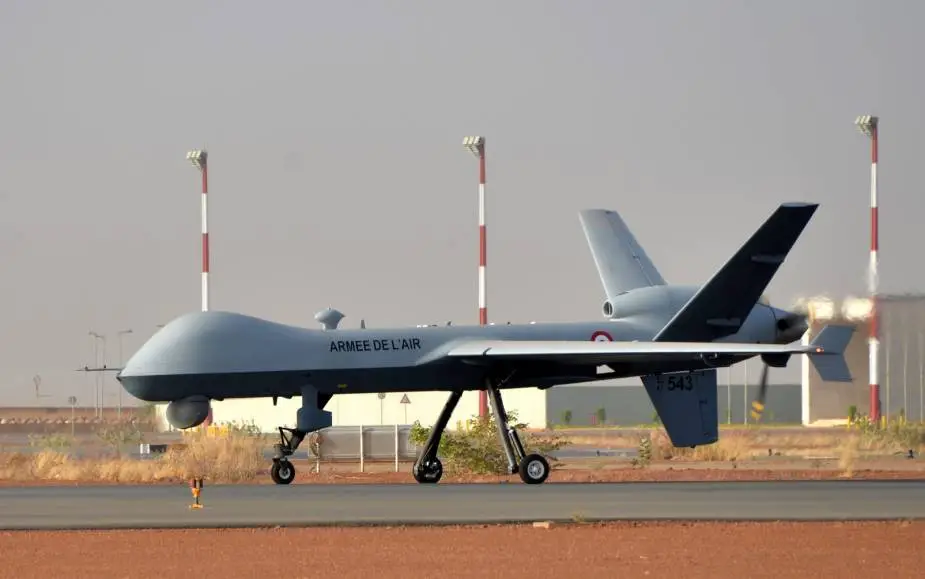On August 17, French Reaper Block 5 delivered for the first time a laser-guided GBU12 ammunition in an operational setting. The block 5 system has thus just taken a new step towards its full operational capacity. It offers more powerful Intelligence, Surveillance and Reconnaissance (ISR) sensors and paves the way for improved kinetic capabilities.
Follow Air Recognition on Google News at this link
 MQ-9 Reaper Block 5 (Picture source: French Armed Forces)
MQ-9 Reaper Block 5 (Picture source: French Armed Forces)
An important capability step has been taken for the Armies, in particular for the Air and Space Force. Reaper Block 5 now has a new operational capability thanks to its GBU 12 ammunition firing qualification. A first experimental campaign was carried out on the Niamey BAP from March to May 2021. Its objective was to test the new Block 5 system in an operational context. A second campaign took place at the end of July to test the carrying and firing capacity of GBU12 on this new standard.
Today, it is done, the armed Reaper Block 5 is employed in operations in the Sahelo-Saharan Strip. The Air and Space Force thus has a drone offering better video and radar quality, improved connectivity, as well as a more versatile weapon capacity. The next milestones will validate the Reaper Block 5 transport of the GBU 49 and the Hellfire missile.
"The Reaper Block 5 allows for better synergy between crews and increased coordination between different players, especially when passing shots. Said Lieutenant-Colonel Mathieu, director of the experimentation campaign. "The ergonomics of the system are simplified, which brings significant added value to operations, as currently in BSS, he added.
Reaper Block 5 also significantly increases real-time intelligence gathering (ISR) capacity, helping to consolidate an already robust targeting process that is fully respectful of international humanitarian law.
These new capabilities, implemented by trained and trained crews, give the Armies responsiveness and adaptation to fulfill an ever-widening range of missions, in BSS and in other theaters.
Operation Barkhane
Led by the French armies, in partnership with the G5 Sahel countries, Operation Barkhane was launched on August 1, 2014. It is based on a strategic approach based on a logic of partnership with the main countries of the Sahel-Saharan strip: Burkina-Faso, Mali, Mauritania, Niger, and Chad. It brings together around 5,100 soldiers whose mission is to fight armed terrorist groups and support the armed forces of partner countries so that they can take this threat into account.
General Atomics MQ-9 Reaper
The General Atomics MQ-9 Reaper (sometimes called Predator B) is an unmanned aerial vehicle (UAV) capable of remotely controlled or autonomous flight operations developed by General Atomics Aeronautical Systems (GA-ASI) primarily for the United States Air Force (USAF). The MQ-9 and other UAVs are referred to as Remotely Piloted Vehicles/Aircraft (RPV/RPA) by the USAF to indicate their human ground controllers.
The MQ-9 is the first hunter-killer UAV designed for long-endurance, high-altitude surveillance. In 2006, the then–Chief of Staff of the United States Air Force General T. Michael Moseley said: "We've moved from using UAVs primarily in intelligence, surveillance, and reconnaissance roles before Operation Iraqi Freedom, to a true hunter-killer role with the Reaper."
The MQ-9 is a larger, heavier, and more capable aircraft than the earlier General Atomics MQ-1 Predator; it can be controlled by the same ground systems used to control MQ-1s. The Reaper has a 950-shaft-horsepower (712 kW) turboprop engine (compared to the Predator's 115 hp (86 kW) piston engine). The greater power allows the Reaper to carry 15 times more ordnance payload and cruise at about three times the speed of the MQ-1. The aircraft is monitored and controlled by aircrew in the Ground Control Station (GCS), including weapons employment.
The MQ-9 Reaper in French service
On 31 May 2013, French Defense Minister Jean-Yves Le Drian confirmed the order of two MQ-9 Reapers, to be delivered by the end of 2013. It was chosen to replace the EADS Harfang and was picked over the Israeli Heron TP. On 27 June 2013, the U.S. Defense Security Cooperation Agency notified Congress of a possible Foreign Military Sale to France for 16 unarmed MQ-9s, associated equipment, ground control hardware, and support, worth up to $1.5 billion total. On 26 August 2013, France and the US Department of Defense concluded the deal for 16 Reapers and 8 ground control stations, with French operators beginning training.
On 24 September 2013, France's first pair of MQ-9 pilots conducted a two-hour training sortie at Holloman Air Force Base, New Mexico. Both French pilots had prior UAV experience and went through a five-week ground-based training course and 5 hours on a flight simulator before the first flight. Two additional crews were also receiving instruction at the facility. General Atomics is due to deliver two Reapers and one ground control station to the French Air Force by the end of 2013. On 26 November 2013, France declared that six pilots in three teams were operational, following 100 hours on flight simulators and 4 flights. French MQ-9s were first put into action in January 2014 at Niamey Air Base in Niger for border reconnaissance in the Sahel desert.
On 16 January 2014, France's first MQ-9 flight occurred from Niger. The first two Reapers to enter French service are designated Block 1 and use U.S. equipment; further orders are to be modified with European payloads such as sensors and data links. On 31 March 2014, French Air Force Reapers accumulated 500 flight hours in support of Operation Serval. In July 2014, a French MQ-9 helped to locate the wreckage of Air Algérie Flight 5017, which had crashed in Mali.
The first operational flight of a French MQ-9 Reaper Block 5 took place on May 14, 2021, from Niamey (Niger) to the Nokara region of Gourma (Burkina Faso).
















